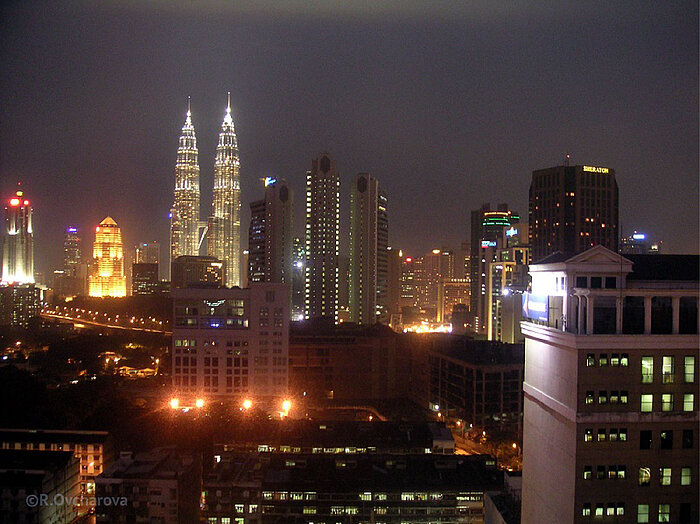马来西亚是东南亚的一个国家,由被南中国海隔开的两个不相邻的地区组成。马来西亚半岛北与泰国接壤,东马位于婆罗洲岛,与文莱和印度尼西亚接壤。此外,马来西亚与新加坡、越南、菲律宾、印度尼西亚和泰国有海上边界。
| Malaysia | ||
|---|---|---|
| Capital: Kuala Lumpur | Density: 101/km2 | Currency: Malaysian ringgit (RM) (MYR) |
| Official languages: Malay | Life expectancy at birth: 76.13 years | GDP (PPP): $1.307 trillion (2024 est.) |
| National Day: 31 August | Area (land): 328,657 km2 | GDP - per capita (PPP): $39,069 (2024 est.) |
| Population: 33,200,000 (2023 est.) | Coastline: 4,675 km | Internet country code: .my |
Source: [1,2,3]
根据2023年的统计,马来西亚 领土面积排名世界第68位,人口约3400万。按人口密度计算,该国居世界第121位。该国海岸线长度为 4,675 公里(马来西亚半岛 – 2,068 公里,东马 – 2,607 公里)。马来西亚是联邦议会君主立宪制国家。国家首都和该国最大的城市是吉隆坡,布城是马来西亚的行政中心。该国分为 13 个州和 1 个联邦直辖区 [1,2,3]。
因此,在这样一个相对的“0-1”图中,该国家的位置按照其在原始评级列表中的位置成比例地用点来标记。如果该国在所选指标方面处于领先地位,则将在相关图表“0-1”的上部绿色区域中标记为接近 1,如果该国在评级列表中属于局外人,则将标记为接近 1图表下方红色区域“0-1”等。
马来西亚经济指数列表排名:
| Sources: 1. GDP (purchasing power parity), 2020 est. / The World Factbook/Library/Central Intelligence Agency *228 2. GDP - per capita (PPP), 2020 / The World Factbook/Library/Central Intelligence Agency *229 3. Inflation rate (consumer prices), 2019 est. / The World Factbook/Library/Central Intelligence Agency *228 4. Charges for the use of intellectual property, receipts (BoP, current US$), 2020 / International Monetary Fund, Balance of Payments Statistics Yearbook, and data files. / License: CC BY-4.0 *88 5. The Global Competitiveness Index 2019 / Rankings / Reports / World Economic Forum *141 6. High-technology exports (current US$) 2019-2020 / United Nations, Comtrade database through the WITS platform / License: CCBY-4.0 / Data *134 7. 2021 Index of Economic Freedom / International Economies / The Heritage Foundation *178 8. Reserves of foreign exchange and gold, 2017 est. / The World Factbook / Library / Central Intelligence Agency *195 9. Annual average GDP growth in %, for the last 10 years (2011-2020) / World Bank national accounts data, and OECD National Accounts data files / License: CC BY-4.0 *206 10. Public debt (% of GDP), 2017 est. / The World Factbook / Library / Central Intelligence Agency (from smallest to largest) *210 * Total number of countries participating in ranking 图 1. 马来西亚经济指数 |
对于大多数指数,马来西亚的排名高于世界平均水平,对于七个指数,马来西亚在评级中排名世界前四分之一。在所提供的指数中,该国的高科技出口和储备(0.93)、2021 年经济自由指数(0.88)以及外汇和黄金储备(0.87)最高。马来西亚经济中最薄弱的环节是公共债务(占 GDP 的百分比)(0.41),这是该国排名低于中间位置的唯一一项指标。
马来西亚拥有已探明的天然气和原油等化石燃料储量。天然气占世界总量的0.58%,石油占0.21%。我国煤炭储量仅占世界总量的0.02%[4]。马来西亚人口约占世界人口的0.42%。然而,与此同时,马来西亚的天然气和石油储量却明显低于世界领先国家。例如,天然气储量比卡塔尔少约 20 倍,而石油储量比伊朗少 58 倍以上 [4,5]。
以吨油当量计算,根据2024年数据,按燃料类型划分的常规探明储量分别为:天然气62.3%、石油28.5%、煤炭9.2%(图5)。
表1. 马来西亚化石能源资源
| Resource /Explanations | Crude oil* | Natural gas* | Coal* | Tight Oil** | Shale Gas** |
|---|---|---|---|---|---|
| Value | 3.6 (0.21%) | 42 (0.58%) | 249 (0.02%) | no date | no date |
| Unit | billion barrels | Tcf | million short tons | - | - |
| Year | 2021 | 2020 | 2021 | - | - |
| Source | [4] | [4] | [4] | [-] | [-] |
*括号内提供了该国储量占世界总储量的比例
**未经证实的技术可采
水力发电在可再生能源装机容量方面占主导地位(几乎 89.2%),其次是生物能源(9.4%)和太阳能光伏发电(约 1.4%)。此外,水力发电在马来西亚发电中发挥着重要作用,约占2021年总发电量的16%。然而,该国并没有完全利用其非常高的总体水力发电潜力(每年414,000GWh[5])。
尽管马来西亚的一些地区,例如婆罗洲岛的西北海岸,在一年中的某些时候,风速相对较强,在 50 m 时达到 5.0-5.5 m/s,但该国总体风速较低。因此,风电在可再生能源的发展方面并不具备强大的潜力。这不适用于太阳能发电,由于有利的气候条件,太阳能发电的发电量可能会高得多。DNI 太阳强度最高达到每天 5.2-5.3 kWh/m 2 ,记录在该国东北部、婆罗洲北部的沙巴州。
表2. 马来西亚的可再生能源资源
| Resource/ Explanations | Hydro Energy Potential | Solar Potential (GHI)* | Wind Potential (50 м)* | Bio Potential (agricultural area) | Bio Potential (forest area) | Municipal Solid Waste |
|---|---|---|---|---|---|---|
| Value | 414,000GWh per year/4,000 potential sites for off-rive pumped hydro | 4.9-5.2 | 3.0-5.0 | 26.1 | 58.2 | 1.21 |
| Unit | - | kWh/m2/day | m/s | % of land area | % of land area | kg/per capita/day |
| Year | 2020/2023 | 2020 | 2020 | 2020 | 2020 | 2018 |
| Source | [6,7] | [8] | [9] | [10] | [11] | [12] |
*对于该国大部分领土来说,
相当广阔的农业和森林面积为开发许多生物能源技术,特别是沼气、生物乙醇或生物柴油的生产提供了良好的资源基础。
SULTAN ISMAIL PETRA. Country: MALAYSIA. Latitude: 6.17, Longitude: 102.29
Wind speed, m/s
SULTAN ISMAIL PETRA. Country: MALAYSIA. Latitude: 6.17, Longitude: 102.29
Sky cover, %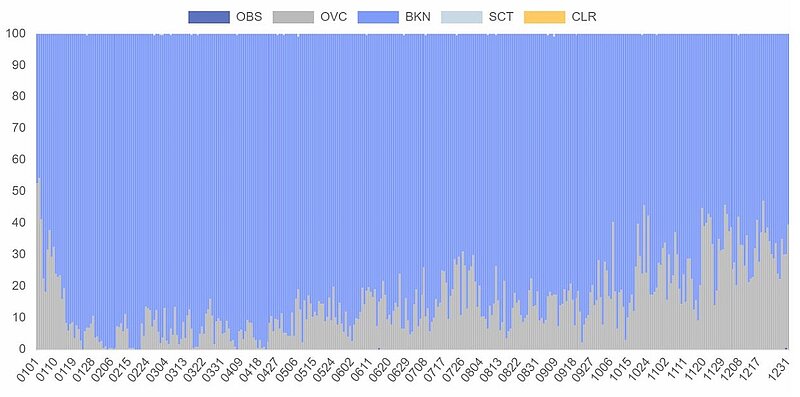
根据[4],2022年马来西亚一次能源总产量为4.185万亿英热单位,而消费量为3.954万亿英热单位。 因此,国内消费占一次能源生产的比重为94.5%。 这使得马来西亚成为一个独立于能源进口的国家。 根据《BP 2022年世界能源统计回顾》,马来西亚2021年的一次能源消耗量为4.19艾焦耳,其中天然气占主导地位 – 35.3%,其次是石油 – 34.8%,煤炭 – 21.2%,水力发电 – 7.2%,以及 其他可再生能源 – 1.4% [5]。
Source: U.S. Energy Information Administration (Mar 2024) / www.eia.gov
2. 马来西亚化石燃料的生产和消费(左 — 煤炭,中 — 天然气,右 — 石油)
马来西亚的天然气产量远远超过国内需求:2022年,天然气消耗量几乎是其产量的一半。相比之下,煤炭的消耗量大约是其产量的10倍。近十年来,石油产量和消费量大致持平,只是略有波动。例如,2022 年石油消耗量比石油产量高出约 10%。
Sources: U.S. Energy Information Administration (Mar 2024) / www.eia.gov | ||
图 3. 马来西亚的发电量 |
过去十年,马来西亚的发电总量增长了约69%,消耗完全由国内生产满足。2022年,约81.4%的电力由火力发电厂生产,16.9%由水力发电厂生产,1.7%由其他可再生能源生产。
| Sources: 1. Crude oil proved reserves, 2021 / International Energy Statistic/Geography / U.S. Energy Information Administration (Nov 2021)*98 2. Natural gas proved reserves 2021 / International Energy Statistic / Geography / U.S. Energy Information Administration (Nov 2021) *99 3. Total recoverable coal reserves 2019 / International Energy Statistic / Geography / U.S. Energy Information Administration (Nov 2021) *81 4. Combination production-consumption for Crude oil 2018 / International Energy Statistic / Geography / U.S. Energy Information Administration (Nov 2021) *219 5. Combination production-consumption for Natural gas 2019 / International Energy Statistic / Geography / U.S. Energy Information Administration (Nov 2021) *123 6. Combination production-consumption for Coal 2019 / International Energy Statistic / Geography / U.S. Energy Information Administration (Nov 2021) *128 7. Electricity – from other renewable sources (% of total installed capacity), 2017 est. / The World Factbook / Library / Central Intelligence Agency *170 8. GDP per unit of energy use (PPP per unit of oil equivalent), 2020 *66 Primary energy consumption - BP Statistical Review of World Energy 2021/BP;GDP (purchasing power parity) - The World Factbook/Library/Central Intelligence Agency 9. Energy use (primary energy use of oil equivalent per capita) 2020 *127 Primary energy consumption – BP Statistical Review of World Energy 2021; Population - United Nations, Department of Economic and Social Affairs, Population Division (2019). World Population Prospects 2019, custom data acquired via website. Retrieved 15 November 2021*66 10. The Global Energy Architecture Performance Index Report (EAPI) 2017 / Rankings / Reports / World Economic Forum 11. Electric power consumption (kWh per capita), 2016 *217 Electricity Consumption - The World Factbook / Library / Central Intelligence Agency; Population - United Nations, Department of Economic and Social Affairs, Population Division (2019). World Population Prospects 2019, custom data acquired via website. Retrieved 15 November 2021 12. Combination of electricity production-consumption (kWh)/The World Factbook/Library/Central Intelligence Agency *216 * Total number of countries participating in ranking 图 4. 马来西亚能源指数 |
马来西亚丰富的化石燃料资源明显反映在能源指数图表中,该国在天然气(0.93)和原油(0.86)的生产消费比指数中表现最好。相比之下,马来西亚能源指标中最弱的部分是煤炭生产消费比(0.05),因为煤炭需求远远超过国内产量。可再生能源在该国能源结构中的参与不足,导致其他可再生能源发电指标(0.34)和全球能源架构绩效指数报告(0.32)的评级相对较低。
图5显示了马来西亚化石燃料行业最大基础设施项目分布的领土地图。如前所述,天然气储量占所有已探明化石燃料储量的62.3%,石油占28.5%,煤炭占28.5%。 – 9.2%。
正在开发的主要天然气田位于马来西亚半岛以及沙巴和砂拉越地区的近海。主要天然气加工厂集中在马来西亚半岛东部。根据美国能源情报署的数据,截至2019年,马来西亚是全球第五大液化天然气出口国。马来西亚巨型液化天然气出口设施位于沙捞越州民都鲁小镇,壳牌第一座商业天然气液化工厂也在那里运营。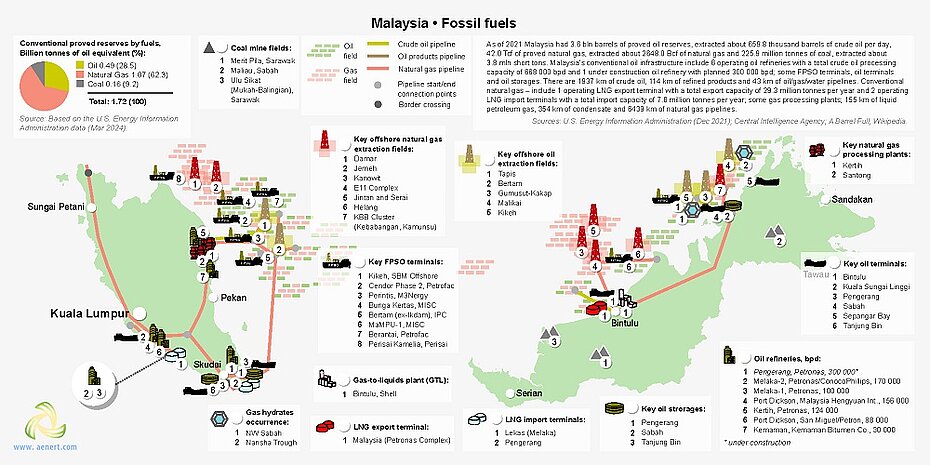
图5.马来西亚化石燃料行业的基本基础设施(点击地图查看PDF版本)
马来西亚的大部分原油来自该国大陆架上的海油田。上面的地图显示了该国两地的主要海上石油开采场、炼油厂和石油储存设施。位于马来西亚半岛南端的边佳兰码头是该国最大的商业石油储存设施。
煤炭开采主要在马来西亚婆罗洲、沙巴州和砂拉越州进行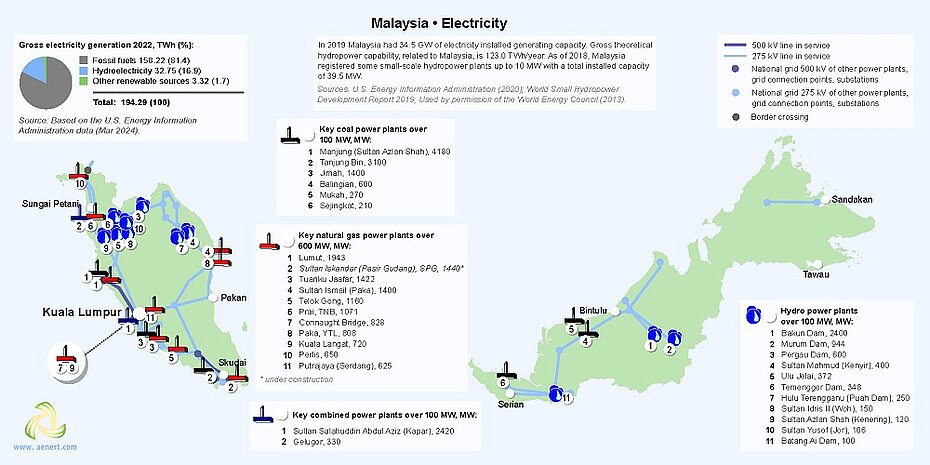
图 6. 马来西亚的电力生产(点击地图查看 PDF 版本)
马来西亚约 81% 的发电量由化石燃料发电站提供,主要由煤炭和天然气满足。水力发电也发挥着重要作用,约占马来西亚发电量的69%,马来西亚婆罗洲的巴贡发电厂是该国最大的水力发电设施,装机容量为2,400兆瓦。如图3所示,马来西亚的电力需求连年增长,政府计划改革该国的电力部门,尤其是开发和进一步开发其相对丰富的水电资源[13].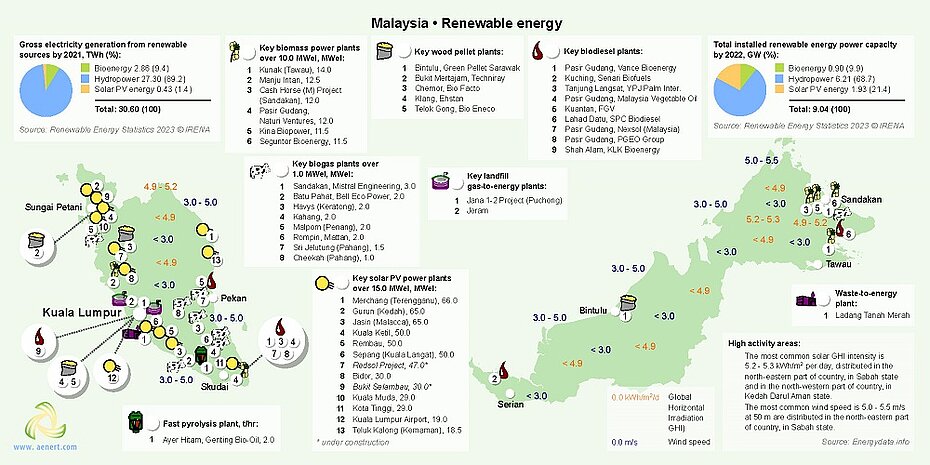
图 7. 马来西亚的可再生能源(点击地图查看 PDF 版本)
在可再生能源装机容量方面,水力发电占主导地位(约占70%),其次是太阳能光伏发电(约占20%)。2021年生物能源的份额略高于10%。与此同时,2021年水力发电厂的发电量约占所有可再生能源发电总量的98.2%,其次是生物能源(9.4%)和太阳能光伏发电(1.4%)。太阳能发电厂分布在马来西亚半岛各地,装机容量在18至66兆瓦之间。在可再生能源的其他领域中,马来西亚正在积极发展生物能源,特别是沼气和生物柴油的生产。
根据《国家能源政策计划》,马来西亚政府的目标是到2050年实现碳中和,并在能源结构中实现70%可再生能源。要实现这一目标,需要在2023年至2050年期间将产能增加十倍以上。该国已制定了到 2035 年,可再生能源在能源结构中占 40% 的目标[13]。
Sources: 1. The Global Innovation Index 2021, Rankings / Knowledge / World Intellectual Property Organization / Cornell University, INSEAD, and WIPO (2021): Energizing the World with Innovation. Ithaca, Fontainebleau, and Geneva *132 2. Patent Grants 2011-2020, resident & abroad / Statistical country profiles / World Intellectual Property Organization *185 3.Patents in Force 2020 / Statistical country profiles / World Intellectual Property Organization *109 4. QS World University Rankings 2022 *97 5. SCImago Country Rankings (1996-2020) / Country rankings / SCImago, (n.d.). SIR-SCImago Journal & Country Rank [Portal]. Retrieved 17 Nov 2021 *240 6. Internet users in 2018 / The World Factbook / Central Intelligence Agency *229 7. Internet users in 2018 (% Population) / The World Factbook / Central Intelligence Agency *229 8. Government expenditure on education, total (% of GDP), 2019 / United Nations Educational, Scientific, and Cultural Organization (UNESCO) Institute for Statistics. License: CCBY-4.0 / Data as of September 2021*177 9. Research and development expenditure (% of GDP), 2018 / UNESCO Institute for Statistics. License: CCBY-4.0 / Data *119 10. Scientific and technical journal articles, 2018 / National Science Foundation, Science and Engineering Indicators. License: CCBY-4.0 / Data *197 * Total number of countries participating in ranking | ||
图8. 马来西亚的教育和创新指数 |
马来西亚在教育和创新领域没有出现极端情况——所有指数都位于图表的中部或上部。其中,马来西亚最好的指标涉及科技期刊文章(0.90)、SCImago国家排名(0.87)和互联网用户数量(0.87)。有效专利(0.66)和政府教育支出(0.66)是图表中最低的指标,但仍高于世界平均水平。
| Sources: 1. CO2 total emission by countries 2020 / European Commission / Joint Research Centre (JRC) / Emission Database for Global Atmospheric Research (EDGAR)*208 2. CO2 per capita emission 2020/European Commission/Joint Research Centre (JRC) / Emission Database for Global Atmospheric Research (EDGAR) *208 3. Forest area 2020 (% of land area) / The Global Forest Resources Assessment 2020 / Food and Agriculture Organization of the United Nations *234 4. Forest area change 2010-2020 (1000 ha/year) / The Global Forest Resources Assessment 2020 / Food and Agriculture Organization of the United Nations *234 5. The Environmental Performance Index (EPI) 2020 / Rankings / Yale Center for Environmental Law & Policy / Yale University *180 6. Annual freshwater withdrawals (m3 per capita), 2017 *179 Annual freshwater withdrawals, total (billion m3), 2017 – Food and Agriculture Organization, AQUASTAT data. /License: CC BY-4.0; Population – United Nations, Department of Economic and Social Affairs, Population Division (2019). World Population Prospects 2019, custom data acquired via website. Retrieved 15 November 2021 7. The National Footprint Accounts 2017 (Biocapacity Credit / Deficit) / Global Footprint Network *188 8. Methane emissions (kt of CO2 equivalent), 2018 / Data for up to 1990 are sourced from Carbon Dioxide Information Analysis Center, Environmental Sciences Division, Oak Ridge National Laboratory, Tennessee, United States. Data from 1990 are CAIT data: Climate Watch. 2020. GHG Emissions. Washington, DC: World Resources Institute. Available at: License : Attribution-NonCommercial 4.0 International (CC BY-NC 4.0) *191 9. The Climate Change Performance Index (CCPI) 2022 / Overall Results / Jan Burck, Thea Uhlich, Christoph Bals, Niklas Höhne, Leonardo Nascimento / Germanwatch, NewClimate Institute & Climate Action Network *60 * Total number of countries participating in ranking | ||
图 9. 马来西亚环境指数 |
马来西亚是二氧化碳排放量(0.12)和甲烷排放量(0.19)最多的国家之一。这些事实是其在国家足迹账户 (0.32) 和 2022 年气候变化绩效指数 (0.11) 中排名较低的部分原因。另一方面,积极指标包括该国的森林面积(0.85)及其积极的增长趋势(0.92)。总体来看,我国环境状况亟待改善。
[1] List of sovereign states and dependencies by area / Wikipedia / en.wikipedia.org/wiki/List_of_sovereign_states_and_dependencies_by_area
[2] List of countries and dependencies by population density / Wikipedia / en.wikipedia.org/wiki/List_of_countries_and_dependencies_by_population_density
[3] Malaysia / The world factbook / Library / Central Intelligence Agency / www.cia.gov
[4] Malaysia / Geography / U.S. Energy Information Administration (December, 2022) / www.eia.gov/beta/international/analysis.cfm
[5] BP Statistical Review of World Energy 2020 - 2022 (PDF) / BP / www.bp.com
[6] Harnessing hydropower in Malaysia/ 7 December 2020/ https://www.waterpowermagazine.com/features/featureharnessing-hydropower-in-malaysia-8396270/
[7] Potential for pumped hydro energy storage in Malaysia/ 7 Mar 2023/ https://www.partnershipsforinfrastructure.org/newsroom/potential-pumped-hydro-energy-storage-malaysia
[8] Solar resource data obtained from the Global Solar Atlas, owned by the World Bank Group and provided by Solargis / Global Solar Atlas / globalsolaratlas.info
[9] Wind Map / Global Wind Atlas 2.0, a free, web-based application developed, owned and operated by the Technical University of Denmark (DTU) in partnership with the World Bank Group, utilizing data provided by Vortex, with funding provided by the Energy Sector Management Assistance Program (ESMAP). For additional information: https://globalwindatlas.info
[10] Agricultural land (% of land area) / Food and Agriculture Organization, electronic files and web site. License: CC BY-4.0 / Data / The World Bank / www.worldbank.org
[11] Forest area (% of land area) / Food and Agriculture Organization, electronic files and web site. License: CC BY-4.0 / Data / The World Bank / www.worldbank.org
[12] What a Waste 2.0 (PDF) / Resources / The World Bank / www.worldbank.org
[13] National Energy Policy 2022-2040 / Ministry of Economy / https://www.epu.gov.my/sites/default/files/2022-09/National%20Energy%20Policy_2022_2040.pdf
图表和曲线的来源在图像下方指定。
有关马来西亚能源行业的更多信息,请参见此处


